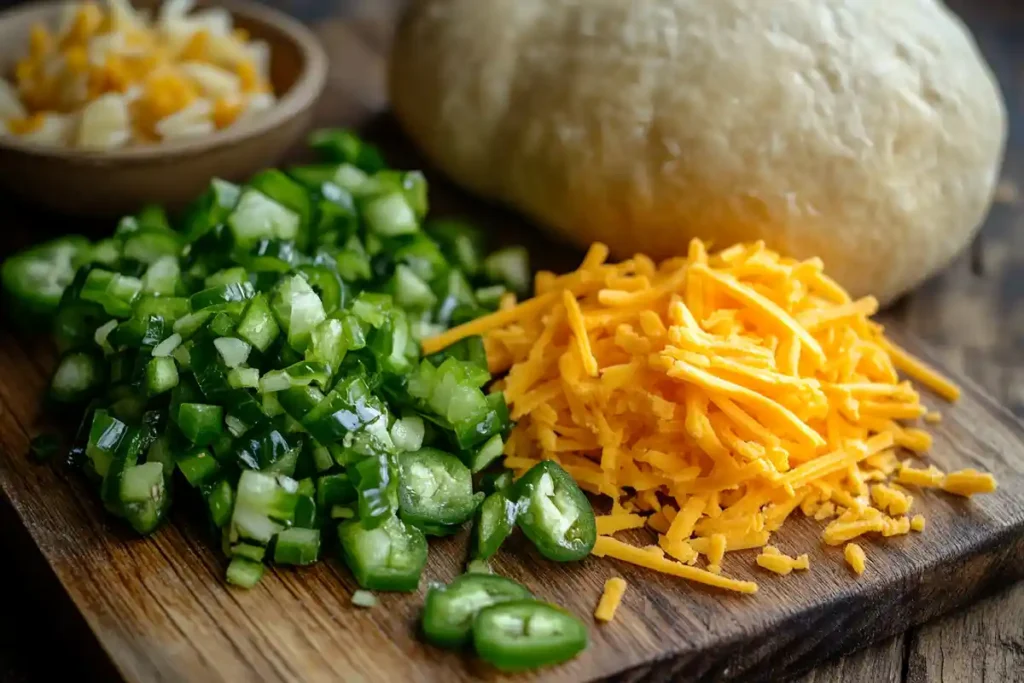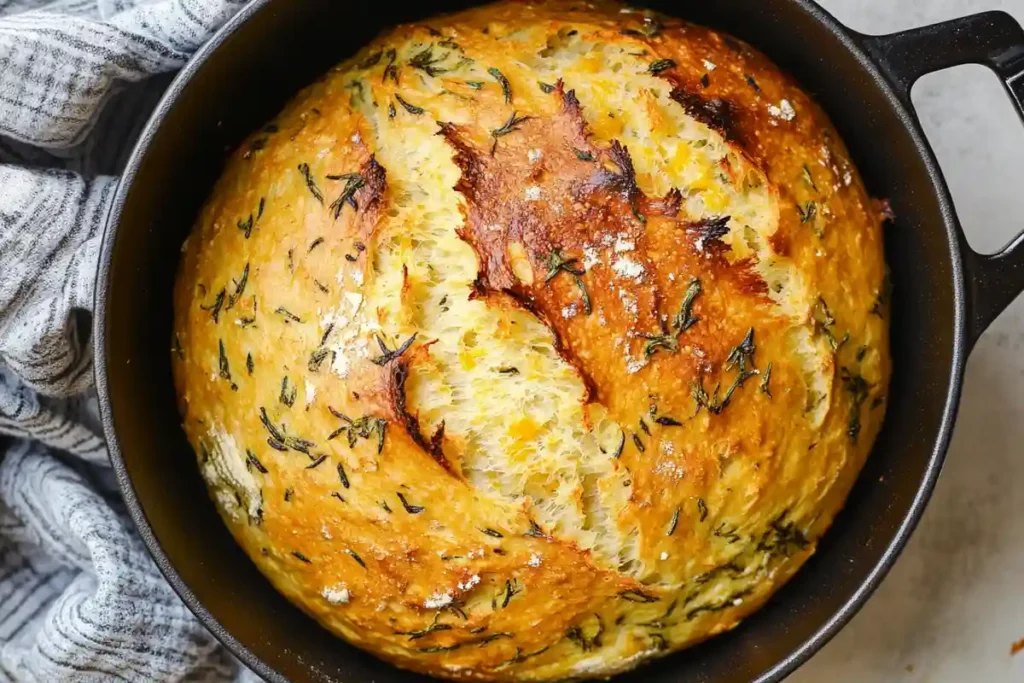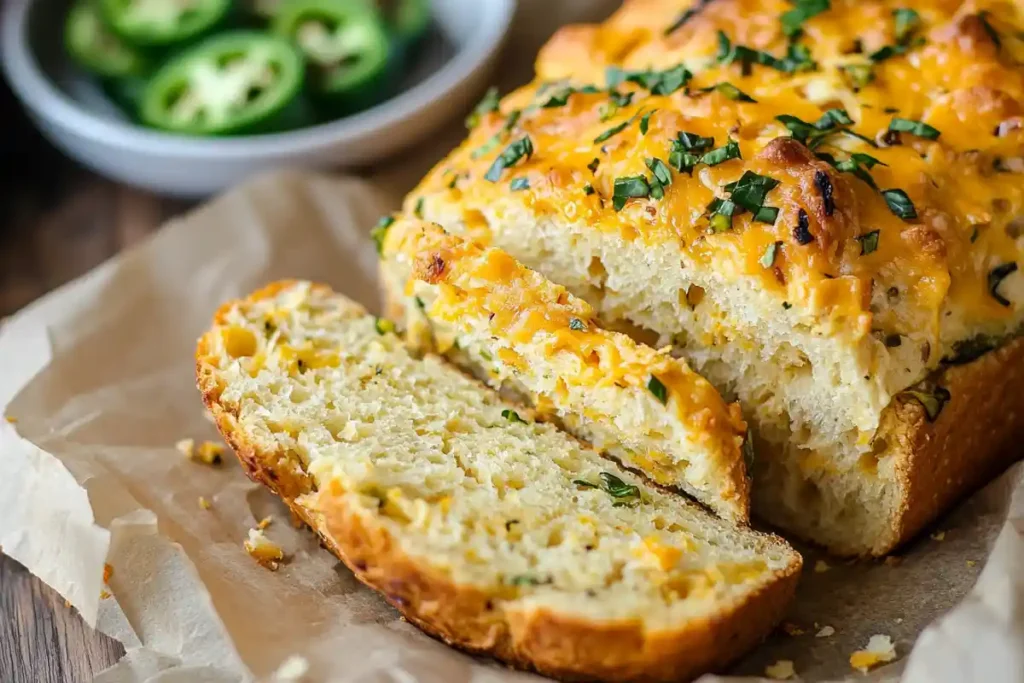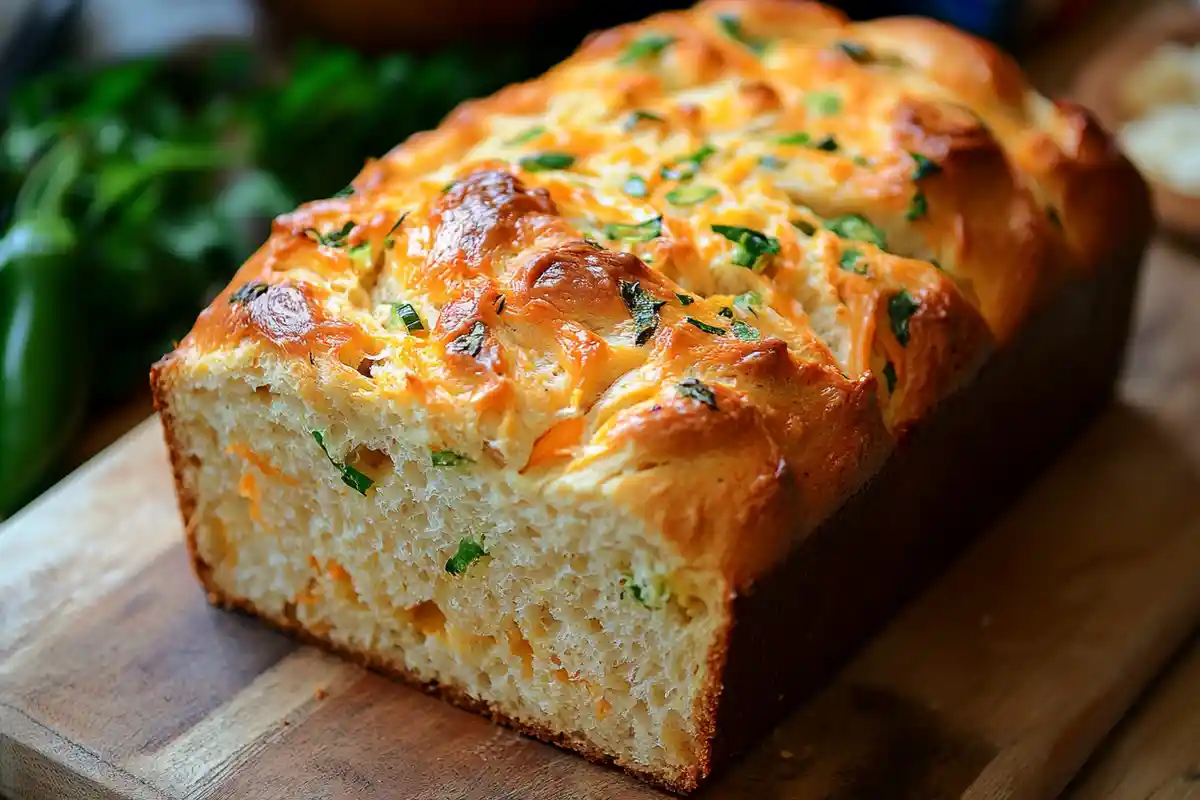Learn how to bake a flavorful, no-knead vegan jalapeno cheddar artisan bread recipe with a spicy kick, gooey cheese, and a perfect crust.
What is Vegan Jalapeno Cheddar Artisan Bread?
Defining Vegan Artisan Bread
Vegan jalapeno cheddar artisan bread recipe is bread made without any animal-derived ingredients, relying instead on plant-based components to achieve a rich and satisfying flavor. It’s crafted with care—no shortcuts—emphasizing high-quality ingredients and traditional techniques. What makes it stand out, though, is how it achieves that perfect balance of texture and taste, even without the usual suspects like butter, milk, or cheese. For this bread, the cheesy flavor comes from vegan cheddar, and the kick of spice comes from fresh jalapeños. It’s a game-changer for those who want their bread to be both plant-based and next-level delicious.
How Vegan Cheddar and Jalapenos Are Incorporated
So, how do we get those signature flavors into vegan jalapeno cheddar bread? Simple. Vegan cheddar (whether shredded or sliced) is folded into the dough during mixing, ensuring pockets of gooey goodness after baking. Meanwhile, diced jalapenos are added for a little heat in every bite—seeds included for those who want a fiery kick, or left out for a milder experience. Together, they infuse the bread with that bold, tangy, and spicy combo that people can’t stop raving about.
Differences Between Vegan and Non-Vegan Jalapeno Cheddar Bread
The biggest difference? It’s all about the swaps. Vegan versions use plant-based cheddar, which mimics the flavor and meltability of regular cheese without using dairy. And instead of butter or milk, this bread often includes olive oil or plant-based milk (like almond or oat) for richness. These swaps not only keep it dairy-free but also make the bread lighter and easier to digest. Taste-wise, you’d barely know the difference—if anything, the vegan version feels fresher and just as indulgent.
Why Make Vegan Jalapeno Cheddar Artisan Bread?
Health Benefits of Vegan Bread Ingredients
One of the top reasons to make this bread is the health benefits of going plant-based. For starters, vegan cheddar is often lower in saturated fats compared to dairy-based cheese, making it a heart-friendly choice. Plus, olive oil, frequently used in vegan baking, is loaded with healthy fats that support your body in so many ways. Jalapenos bring antioxidants and vitamin C to the table, while whole grain or unbleached flours can add fiber and nutrients to your diet. Altogether, this bread can satisfy your cravings and keep things wholesome. Win-win!
Spicy Flavor Profile and Its Popularity in Baking
Why is spice having a moment? Honestly, it’s because people love a bold flavor that shakes up the everyday. The combination of spicy jalapenos and creamy cheddar creates that addictive contrast—perfect for a stand-alone snack or pairing with soups and salads. It’s no surprise this flavor is trending, especially as more home bakers experiment with savory, flavor-packed recipes.
Environmental Impact of Vegan Baking
Another awesome reason to make this bread? You’re doing the planet a solid. Baking vegan cuts down on the environmental footprint by skipping dairy and eggs, which are resource-heavy to produce. Plus, plant-based ingredients are more sustainable overall, especially when you opt for organic or locally-sourced options. Every loaf is a small step toward making food systems greener and more sustainable.
If you’re curious about other plant-based recipes, check out our vegan lunch ideas for more inspiration on incorporating delicious, dairy-free dishes into your meals.
Who Would Enjoy This Recipe?
Ideal for Vegans and Non-Vegans Alike
Think this vegan jalapeno cheddar artisan bread recipe is just for vegans? Nope! Even non-vegans are going to love it. The spicy, cheesy flavor profile is so universal that it appeals to anyone looking for a fun twist on classic artisan bread. It’s perfect for introducing friends or family to vegan baking without them even realizing they’re “missing” the dairy. Plus, it’s a great conversation starter—everyone will want to know your secret ingredient.
Great for Bread Enthusiasts and Home Bakers
If you’re a bread nerd (hey, no judgment—I’m one too) or just a home baker looking to level up, this recipe is for you. It’s not overly complicated but still feels like an accomplishment when it comes out of the oven golden and perfect. That’s the beauty of no-knead techniques—it makes artisan bread accessible to anyone, even if you’re new to baking.
Common Misconceptions About Vegan Artisan Bread
Misconception: Vegan Bread Lacks Flavor
Vegan jalapeno cheddar artisan bread recipe is boring.” Heard that one before? Yeah, me too. But it’s just not true. The richness of olive oil, the sharpness of vegan cheddar, and the zesty heat from jalapeños make this bread anything but bland. The key is using high-quality ingredients and seasoning your dough well (hello, salt!). Trust me—this bread is proof that vegan recipes can be just as flavorful as their traditional counterparts.
Addressing Concerns About Texture Without Dairy
Another common worry is that vegan bread won’t have the same soft, chewy texture. Here’s the thing: texture in bread comes from gluten development and hydration, not necessarily from dairy. When you let the dough rest (thanks, no-knead method!), it forms that perfect structure naturally. And if you use a good vegan cheddar that melts well, you’ll get gooey, cheesy pockets that rival any dairy-filled bread out there.
Understanding the Basics of Vegan Jalapeno Cheddar Artisan Bread
Key Ingredients in the Recipe

The magic of vegan jalapeno cheddar artisan bread recipe lies in its carefully chosen ingredients. Every component works together to create a loaf that’s bursting with flavor while remaining entirely plant-based. The base usually consists of unbleached all-purpose or bread flour, which gives the bread its structure. For hydration, plant-based milk or water is used, often with a dash of olive oil to add richness. The star ingredients—vegan cheddar and fresh jalapeños—take the flavor profile to the next level. Salt, sugar, and yeast round out the essentials, ensuring proper fermentation and a balanced taste.
Vegan Cheddar Options and Brands
Not all vegan cheese is created equal. When it comes to cheddar, some brands melt better than others, making them ideal for baking. Violife, Daiya Cutting Board Cheddar, and Miyoko’s Creamery are popular choices that deliver both taste and texture. These cheeses mimic the sharpness of traditional cheddar and melt into gooey pockets when baked. For an extra cheesy experience, shredded options work best, but slices can also be chopped up and folded into the dough.
Jalapeno Selection for Optimal Flavor
The heat level of your bread depends on the jalapenos you choose. For a spicier kick, use fresh jalapenos with seeds included. On the other hand, for a milder flavor, remove the seeds and membranes before dicing. If fresh jalapenos aren’t available, pickled jalapenos can be an excellent substitute, adding both heat and tanginess. Whatever you pick, make sure to dice the jalapenos evenly to ensure every bite has a bit of that zesty goodness.
Role of Fermentation in Artisan Bread
Benefits of No-Knead Techniques
No-knead bread has become a favorite for home bakers, and for good reason. The long fermentation time does all the hard work, allowing the gluten to develop naturally. This method is not only convenient but also produces a chewy, airy texture that’s hard to replicate with traditional kneading. Plus, the hands-off approach means you can mix the dough, let it rest, and come back hours later to find it ready for baking. Who doesn’t love a low-effort, high-reward recipe?
Tools and Equipment Needed
Dutch Oven vs. Alternative Baking Methods
Baking artisan bread in a Dutch oven is the gold standard. It creates a steamy environment that helps the bread rise and develop a crispy crust. But don’t worry if you don’t have one—there are plenty of alternatives. For instance, you can bake your bread on a preheated baking stone or sheet, placing a pan of hot water in the oven to generate steam. Another option is to cover the loaf with a heatproof bowl or foil for the first half of the baking process to trap moisture.
Baking Without a Dutch Oven: Tips and Tricks
If you’re going Dutch oven-free, timing and preparation are key. Preheat your baking surface to ensure a good oven spring, and use a water sprayer to mist the dough right before it goes into the oven. This mimics the steam environment needed for a crusty exterior. Be sure to monitor your bread closely, as alternative methods may require slight adjustments to baking time and temperature.
Essential Tools for No-Knead Bread
Beyond a Dutch oven, a few basic tools will make your bread-baking experience smoother. A large mixing bowl is a must for combining ingredients, while a sturdy spatula or dough scraper helps with mixing and handling the sticky dough. For precision, a digital scale is invaluable—accurate measurements can make or break your bread. Finally, parchment paper makes transferring dough to the oven a breeze, reducing the chance of sticking.
Measuring and Mixing Essentials for Consistency
Consistency is everything when baking, and that starts with proper measuring. Use a digital scale for dry ingredients and a measuring cup for liquids. When mixing, avoid overhandling the dough—the goal is to combine everything just until incorporated. This gentle approach preserves the gluten structure, resulting in a tender crumb.
The Science Behind No-Knead Bread Techniques
How Gluten Develops Without Kneading
Here’s the fascinating part: gluten development doesn’t require endless kneading. With no-knead bread, time does the heavy lifting. During the long fermentation process, water interacts with the flour, slowly aligning gluten strands. This creates the elasticity needed for a chewy, well-structured loaf. Patience is key, as rushing this step can lead to dense or uneven bread.
The Role of Time and Hydration in Bread Texture
Time and hydration are the secret ingredients for perfect artisan bread. The high hydration level in no-knead recipes allows the dough to remain soft and pliable, which contributes to the airy, open crumb. Meanwhile, extended resting periods enhance flavor development as natural fermentation occurs. These factors combine to give you a bakery-worthy loaf without the need for elbow grease.
Best Vegan Alternatives for Jalapeno Cheddar Bread
Vegan Cheese Options: Melting and Taste Factors
As mentioned earlier, not all vegan cheeses are created equal. For bread, you want a cheese that melts well and has a bold flavor to stand out against the jalapenos. Brands like Follow Your Heart and Daiya offer cheddar-style shreds that work beautifully. Some home bakers even opt to make their own vegan cheese using cashews or nutritional yeast for a custom flavor.
For those exploring more plant-based cheese options, you might also enjoy our guide on Gruyère cheese alternatives for vegan-friendly swaps and creative ideas.
Plant-Based Milk Substitutes for Dough Hydration
When it comes to hydrating your dough, plant-based milk options are endless. Almond milk is light and slightly nutty, while oat milk adds creaminess. Soy milk, on the other hand, is neutral and works well in most recipes. Whichever you choose, make sure it’s unsweetened to avoid altering the bread’s flavor.
Combining Jalapenos with Other Ingredients for Variation
Want to take your bread up a notch? Try pairing jalapenos with complementary ingredients like roasted garlic, caramelized onions, or fresh herbs. These additions can bring depth to the flavor while keeping the spotlight on the spicy and cheesy elements. For a smoky twist, consider adding diced chipotle peppers or smoked paprika.
Tips for Perfecting Your Vegan Jalapeno Cheddar Bread
Balancing Spiciness and Cheesiness
Getting the right balance of heat and creaminess is crucial. Start with a smaller amount of jalapenos and gradually increase if you’re unsure about the spice level. Similarly, don’t skimp on the cheese—those gooey pockets are what make this bread irresistible. Taste as you go to ensure the flavors work in harmony.
How to Prevent Overproofing or Undercooking
Overproofed dough can collapse, while underproofed dough may not rise properly. To avoid this, keep an eye on the dough’s volume during proofing. It should roughly double in size but still feel slightly firm when pressed. For baking, use an instant-read thermometer to check the internal temperature—a fully baked loaf will register around 200°F (93°C).
Storing Bread to Maintain Freshness
Once your bread is baked, proper storage is key to keeping it fresh. Let it cool completely before wrapping it in a clean kitchen towel or storing it in a bread box. If you’re not eating it within a couple of days, slice the loaf and freeze individual portions. Reheat in the oven or toaster for that just-baked taste.
Step-by-Step Recipe for Vegan Jalapeño Cheddar Artisan Bread
Ingredients and Measurements
This recipe is straightforward, and the ingredients are easy to source. Here’s what you’ll need:
For the Dough:
- 3 ½ cups bread flour (or all-purpose flour)
- 1 ¾ teaspoons salt
- 1 teaspoon sugar
- 1 packet (2 ¼ teaspoons) instant yeast
- 1 ½ cups warm water (around 110°F) or unsweetened plant-based milk
- 1 tablespoon olive oil
For the Mix-ins:
- 1 cup shredded vegan cheddar (Violife, Daiya, or your favorite brand)
- 2–3 fresh jalapeños, diced (adjust for spice preference)
Adjustments for Dietary Preferences (e.g., Gluten-Free)
For a gluten-free version, swap the bread flour for a gluten-free all-purpose baking blend with xanthan gum. You may need slightly less water since gluten-free flours absorb more liquid.
Mixing and Preparing the Dough
Combining Dry and Wet Ingredients
- In a large mixing bowl, whisk together the flour, salt, sugar, and yeast.
- Slowly add the warm water or plant-based milk, mixing with a wooden spoon or your hands until a shaggy dough forms.
- Drizzle in the olive oil and knead lightly (if needed) to ensure all the flour is hydrated.
Incorporating Jalapeños and Vegan Cheddar
- Gently fold in the diced jalapeños and shredded vegan cheddar. Be careful not to overmix—you want an even distribution of ingredients without overworking the dough.
- Cover the bowl with plastic wrap or a damp kitchen towel and let the dough rest at room temperature for 8–12 hours. The long fermentation allows the flavors to deepen and the gluten to develop naturally.
Proofing and Baking the Bread

How to Achieve Perfect Rise During Proofing
Once the dough has doubled in size (it’ll look bubbly and soft), it’s ready for shaping. Lightly flour a clean surface and your hands. Turn the dough out, shape it into a round boule, and let it proof again for 30–60 minutes while your oven preheats.
Baking Instructions With and Without a Dutch Oven
With a Dutch Oven:
- Place the Dutch oven (with its lid) into your oven and preheat to 450°F for at least 30 minutes.
- Carefully transfer the dough onto parchment paper, then into the hot Dutch oven. Cover with the lid and bake for 30 minutes.
- Remove the lid and bake for an additional 10–15 minutes to achieve a golden, crisp crust.
Without a Dutch Oven:
- Preheat a baking stone or a heavy-duty baking sheet in the oven.
- Transfer the dough onto the preheated surface and immediately add a tray of water to the bottom rack for steam.
- Bake at 450°F for 40–45 minutes or until the crust is deeply golden and the bread sounds hollow when tapped.
Common Challenges and Solutions
Why Did My Bread Not Rise?
If your bread didn’t rise, it could be due to expired yeast, overly cold water, or insufficient fermentation time. Always check your yeast freshness and aim for a warm, draft-free spot for proofing.
How to Avoid Dense or Gummy Bread
Dense bread often results from underproofing or too much liquid in the dough. Ensure the dough has risen properly and measure liquids accurately. Also, baking it long enough (internal temperature should hit 190°F) prevents a gummy crumb.
Tips for Evenly Distributed Ingredients
To avoid clumps of jalapeños or cheese, fold the mix-ins into the dough in smaller batches. Adding them too early can also lead to uneven distribution, so incorporate them after the initial mix.
Creative Variations of the Recipe
Adding Herbs and Spices for Extra Flavor
Take this bread up a notch with herbs like rosemary, thyme, or parsley. A sprinkle of smoked paprika or cumin in the dough pairs beautifully with the jalapeños and cheddar for a smoky, earthy kick.
Stuffed Bread Versions with Additional Ingredients
Why stop at just jalapeños and cheddar? Try stuffing the bread with roasted garlic cloves, caramelized onions, or sun-dried tomatoes for a flavor explosion in every bite.
Sweet and Spicy Jalapeño Bread Options
For a unique twist, add a touch of sweetness. Mix in a tablespoon of maple syrup or agave nectar to the dough, or top the loaf with a drizzle of vegan honey for a sweet-and-spicy combo that’s perfect for breakfast toast.
Future Trends in Vegan Baking
Innovations in Plant-Based Cheese Alternatives
The vegan cheese world is booming, with brands developing options that melt, stretch, and taste just like traditional cheese. In the future, we’ll likely see even more artisan-style vegan cheeses, making recipes like this one even better.
Increasing Popularity of Artisan No-Knead Breads
No-knead bread techniques have already transformed home baking, but their popularity will keep growing as more people realize how easy it is to make bakery-quality loaves at home. Combined with the rise of plant-based eating, vegan artisan bread is set to become a go-to for foodies everywhere.
What is the Best Vegan Jalapeño Cheddar Artisan Bread Recipe?
Key Elements of a Good Recipe
A great vegan jalapeño cheddar artisan bread recipe focuses on three essentials: bold flavor, perfect texture, and ease of preparation. Key elements include high-quality vegan cheddar that melts well, fresh jalapeños for a spicy kick, and the no-knead technique for a soft crumb and crispy crust. Using a Dutch oven helps achieve a professional finish, but alternative methods work just as well if you’re improvising.
Tips for Picking the Right Ingredients
When selecting ingredients, prioritize freshness. Opt for ripe jalapeños with firm skins, and choose vegan cheddar with a flavor you enjoy straight out of the package. For the flour, bread flour is the top choice for structure, but all-purpose flour works if that’s what you have.
Can I Make Vegan Jalapeño Cheddar Artisan Bread Without Kneading?
How the No-Knead Method Works
Yes, absolutely! The no-knead method is what makes this recipe so approachable. Instead of kneading to develop gluten, the dough undergoes a long fermentation process. The water and yeast work together over time to build the dough’s structure, creating that artisan texture without the effort.
Advantages of the No-Knead Process
The biggest advantage? Simplicity! You mix everything in one bowl, let it rest, and the dough basically takes care of itself. Plus, the no-knead technique gives the bread its signature open crumb and chewy bite, something that’s hard to replicate with traditional methods.
How Do I Bake Jalapeño Cheddar Bread Without a Dutch Oven?
Alternative Baking Techniques
If you don’t have a Dutch oven, don’t worry—you can still make incredible bread. Use a deep baking dish covered with foil, or try a heavy-duty baking sheet combined with a metal bowl to trap steam. A pizza stone is another great option for achieving a crispy crust.
Tools That Can Substitute for a Dutch Oven
- A cast iron skillet with a lid
- A stockpot (oven-safe, of course!)
- A casserole dish covered tightly with aluminum foil
Just remember, the goal is to create steam for a crusty exterior while the bread bakes.
What Are the Best Substitutes for Cheese in This Recipe?
Vegan Cheese Options That Melt Well
Vegan cheese is an evolving market, but there are some standout options for this bread. Violife and Daiya are fan favorites for their melting ability, while brands like Miyoko’s bring a more sophisticated flavor. If you can’t find vegan cheddar, opt for nutritional yeast to add a cheesy, umami flavor.
How to Enhance Cheesiness Without Dairy
Want extra cheesiness? Try adding nutritional yeast directly into the dough or mixing it with olive oil to brush over the top before baking. You can also blend cashews, lemon juice, and miso paste to create a rich, cheesy drizzle to serve alongside your bread.
How Do I Store and Reheat Vegan Jalapeño Cheddar Bread?

Maintaining Freshness Over Several Days
To keep your bread fresh, wrap it in a clean kitchen towel and store it in a bread box or paper bag. Avoid plastic, as it can make the crust soggy. If you won’t finish it within a few days, slice and freeze individual pieces in an airtight container or freezer bag.
Reheating for Optimal Texture and Flavor
Reheat slices in a toaster oven for a crispy crust, or warm the whole loaf in a preheated oven at 350°F for about 10 minutes. Add a little steam (place a small dish of water in the oven) to refresh the crust if it’s gone stale.
What Makes This Recipe Different from Traditional Jalapeño Cheese Bread?
Vegan-Friendly Ingredient Swaps
The main difference is, of course, the use of plant-based alternatives instead of dairy products. This recipe swaps regular cheddar for vegan cheddar and uses plant-based milk or water for hydration. These swaps don’t compromise flavor—they just make the bread accessible to more people.
Health and Taste Comparisons
Vegan jalapeño cheddar bread is lighter on the stomach and lower in saturated fat compared to traditional versions. Plus, the combination of jalapeños and vegan cheddar creates a flavor that’s just as rich and satisfying, proving you don’t need dairy to make an incredible loaf.

